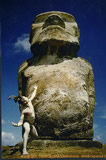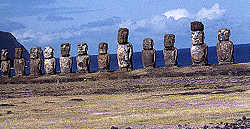
Contrasting with the Polynesians, who carved their ancestors' images in wood, the Rapa-Nui sculpted their Moais in volcanic stone obtained from the Rano Raraku Volcano's quarry, where, until our days, seventy unfinished Moais remain as if they were sleeping.
The production's decline of these monumental sculptures is due to the internal crisis created by power struggles and food scarcity in the island.
The Moais are 4 meters hight, excepting Moai Paro which is 10 meters high and weighs 85 tons. Ahu Te Pito Kura, the ceremonial center, is the final expression of the megaliths used as symbols of political and religious power in the context of the crisis experienced by the Rapa Nui society.

The moais, were directly sculpted in volcanic rock, using basalt stone-cutters.
Once finished, they were lifted, and carried to the volcano's foot, using ropes made out of vegetable fibers. After placing them in the upright position, the Rapa Nui carved the moais' eyes, noses, and elongated ears, while tattooing its back. By dragging them with ropes and wooden structures, or by pushing them with bascular movements - as if they were walking by themselves - they were transported to a given ceremonial shrine.
The long and hard task of moving one of these sculptures ended when the moai was placed on the ahu or shrine, with the ocean at its back. Here Ariki, the King, presided the ritual to invest the moai with a power capable of protecting the lineage and the island.
Only after this ceremony, the moai received its eyes made from white coral and obsidian, and its hat, made from red stone, similar to the red tinted coif or turban that the Arikis used as a simbol of their divinity.

The Ahu are stone platforms, inspired by the marae, an old Polynesian prototype. The Rapa Nui added to this basic pattern other constructions, creating a different ceremonial monument, the Ahu. They integrated stone images, the Moai; adding an inclined frontal plane, called Tahya, paved with round stones, the Poro, with wide lateral extensions, and a crematory.
1000 years, the Rapa Nui builders, the Tangata Maori Anga Ahu, erected almost three hundred Ahu, most of them located on the coastal line.
The chosen place for building an Ahu was sacralized by means of a ceremonial that included a cover of red soil as a base. This color, in Polynesia, symbolized the sacred, the war, the crops, fertility and human sacrifices.

According to William Mulloy (American archaeologist), the ahu evolved gradually, experiencing no major changes caused by external influence. This theory contradicts another Rapa Nui tradition that speaks about a second migratory wave that brought the Hanau Epe, a strong people, that subjugated the original community brought by Hotu Matua, known as Hanay Momkor, or thin race.
Tongariki is the biggest ahu of all. This ahu is located in the south coast and had a forty-five meters long platform, expandable up to one hundred and sixty meters, with lateral extensions, that hosted about 15 moai with red stone hats.
Tahai: Its first period of construction is in the year 700 A.C. This ahu already presents several innovations, what suggests a relatively long time of local adaptation and evolution. Ariki Tuu Ko Ihu is Hotu Matua's companion who is thought as the creator of the first wooden Moai.
The Ariki would have seen two spirits that inspired him to create the Kava Kava Moai (of prominent ribs). Then, a female spirit appeared before him, and from this image he created the Pa'a Pa'a Moai.